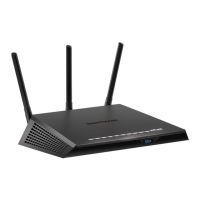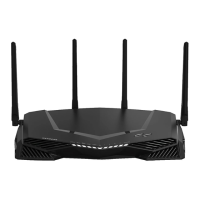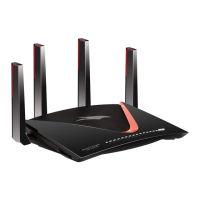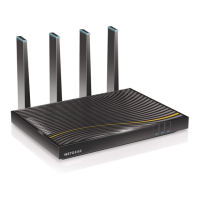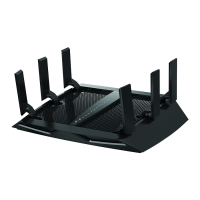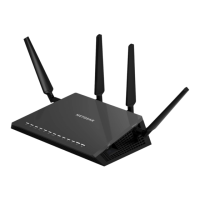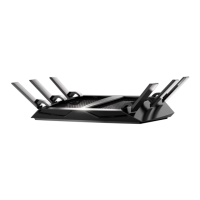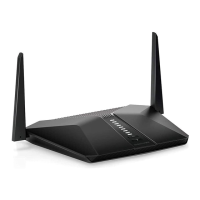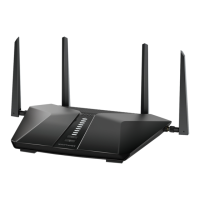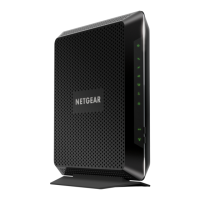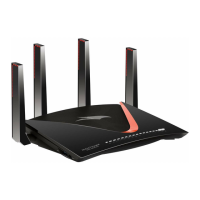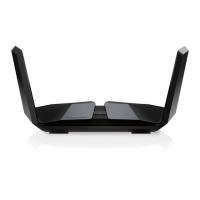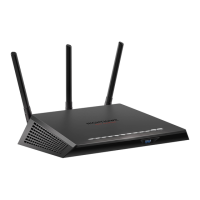
Do you have a question about the NETGEAR Nighthawk Pro XR300 and is the answer not in the manual?
| WiFi Technology | 802.11ac |
|---|---|
| WiFi Range | Medium to large homes |
| Processor | Dual-core processor |
| Beamforming | Yes |
| WiFi Speed | AC1750 (450Mbps @2.4GHz + 1300Mbps @5GHz) |
| WiFi Band | Dual-band (2.4 GHz & 5 GHz) |
| Memory | 128 MB Flash |
| Ethernet Ports | 4 x Gigabit LAN ports |
| WAN Port | 1 x Gigabit Ethernet WAN port |
| QoS | Yes (DumaOS) |
| Security | WPA2 |
| VPN Support | Yes |
Details on unpacking the router, power adapter, and Ethernet cable.
Explanation of the status LEDs located on the top panel of the router.
Description of the connectors and buttons on the router's rear panel.
Instructions on positioning router antennas for optimal WiFi performance.
Information about the router label containing login details and MAC address.
Guidelines for optimal router placement to maximize WiFi range and performance.
Step-by-step instructions for connecting the router to a modem and power.
Methods for connecting computers to the router via wired or WiFi connections.
Explanation of different login types: ISP, WiFi password, and router admin login.
Steps to access the router's web interface using a browser for settings management.
Guide to managing the router using the NETGEAR Nighthawk mobile application.
Guidance on using the setup wizard to automatically configure Internet connection settings.
Instructions for manually configuring the router's Internet connection settings.
Configuration steps for setting up IPv6 Internet connections if not auto-detected.
Procedure for adjusting the Maximum Transmission Unit (MTU) size for network performance.
Using the Geo Filter to limit game server distance for better response times.
Allocating and managing bandwidth for specific devices to prevent congestion.
Prioritizing network traffic for specific devices to reduce lag.
Viewing and managing connected devices, including blocking or renaming them.
Monitoring network traffic, categories, and applications consuming bandwidth.
Accessing detailed system information about the router's status and components.
Personalizing the router's dashboard by adding, removing, or rearranging panes.
Blocking specific websites or domains using keywords or schedules.
Configuring outbound firewall rules to block specific services and applications.
Creating schedules to activate blocking rules for sites, services, and applications.
Configuring email alerts for security events and router log messages.
Configuring Wide Area Network (WAN) settings, including DMZ and MTU.
Configuring a DMZ server to bypass firewall security for specific applications.
Customizing the router's device name for file sharing and network identification.
Modifying the router's Local Area Network (LAN) IP address and RIP settings.
Configuring the pool of IP addresses that the router's DHCP server assigns.
Disabling the router's DHCP server to use another DHCP server on the network.
Assigning static IP addresses to specific devices on the local network.
Configuring a bridge for devices like IPTV to bypass NAT and access ISP network directly.
Defining static routes for specific network traffic paths, often for complex network setups.
Enabling UPnP for devices to automatically discover and connect to network resources.
Configuring fundamental WiFi settings like SSID, channel, and region for 2.4/5 GHz bands.
Modifying the WiFi network password and security protocol (WPA/WPA2).
Adjusting WiFi transmission speeds (Mbps) for 2.4 GHz and 5 GHz bands.
Adjusting the router's WiFi transmission power to manage coverage and save energy.
Creating a separate WiFi network for guests, isolating them from the main network.
Setting up enterprise-level WiFi security using RADIUS servers for authentication.
Configuring older WEP security, which is less secure and slower than WPA/WPA2.
Enabling or disabling the router's WiFi radios using the On/Off button or web interface.
Using WPS to easily connect WiFi devices without manually entering passwords.
Scheduling WiFi signal to turn off automatically during specific times or days.
Configuring WPS settings, including the router's PIN for device connections.
Disabling implicit beamforming to potentially improve WiFi speed and reliability.
Managing airtime fairness to ensure all clients receive equal network time.
Configuring the router to function solely as a WiFi Access Point (AP).
Checking for and installing new firmware to update the router's software.
Procedure for changing the router's administrative login password for security.
Setting up password recovery options in case the admin password is forgotten.
Steps to recover the router's admin password using security questions.
Backing up, restoring, or erasing the router's configuration settings.
Connecting to and managing the router remotely via the NETGEAR Nighthawk mobile app.
Monitoring internet traffic volume, setting limits, and viewing usage statistics.
Viewing and managing the router's activity log for security events and network actions.
Viewing statistics for the router's WAN, LAN, and WiFi ports.
Checking the router's internet connection status and managing IP address leases.
Remotely restarting the router through its web-based administration interface.
Viewing any notifications generated by the router regarding its status or events.
Customizing the behavior of the router's LED indicators, including blinking and power status.
Details on USB device compatibility, file system types, and power supply requirements.
Steps for physically connecting a USB storage device to the router's USB port.
Accessing files on a USB storage device connected to the router from a Windows PC.
Mapping a USB storage device as a network drive in Windows for easier access.
Accessing files on a USB storage device connected to the router from a Mac computer.
Using ReadySHARE Vault software to perform automatic backups of Windows computers.
Using Time Machine to back up Mac computers to a USB drive connected to the router.
Configuring access methods and permissions for USB storage devices connected to the router.
Setting up FTP access to transfer files within the local network from USB storage.
Viewing, adding, or changing network folders on a USB storage device connected to the router.
Configuring the router to allow only specific approved USB devices to connect.
Steps to safely take a USB storage device offline before physically disconnecting it.
Setting up a personal FTP server for remote access to network storage via Dynamic DNS.
Configuring Dynamic DNS service to access the home network using a domain name.
Accessing USB storage devices connected to the router remotely via the Internet.
Configuring the router as a DLNA/UPnP AV media server for compatible players.
Enabling TiVo support to play media files from USB storage on a TiVo device.
Installing printer drivers and connecting a USB printer to the router for network sharing.
Downloading the NETGEAR ReadySHARE printer utility for Windows and Mac computers.
Installing the ReadySHARE utility to manage shared USB printers.
Using the NETGEAR USB Control Center to print documents through the shared USB printer.
Establishing a virtual private network (VPN) connection for secure remote network access.
Configuring the router with VPN service settings, including UDP/TCP and port numbers.
Installing OpenVPN client software on computers and mobile devices for VPN connections.
Establishing a VPN tunnel from a Windows computer to the router for secure access.
Accessing router USB storage and media files remotely via a VPN connection.
Using a VPN connection to access your home internet service while away from home.
Configuring port forwarding rules to allow specific incoming traffic to local servers.
Setting up port triggering for dynamic opening of ports based on outbound traffic.
General tips and sequences for troubleshooting common router problems.
Diagnosing router issues by interpreting the status and behavior of the LED indicators.
Troubleshooting steps for resolving issues preventing login to the router's web interface.
Diagnosing and resolving problems when the router is connected but cannot access the Internet.
Resolving issues where the router has an IP but web pages fail to load.
Troubleshooting why configuration changes made in the router's web interface are not being saved.
Steps to diagnose and resolve problems with WiFi connection to the router.
Using the ping utility to test network connectivity and diagnose issues.
Details on the router's default factory settings and how to restore them.
Technical specifications of the router, including hardware, power, and environmental details.
